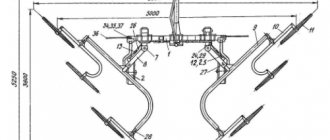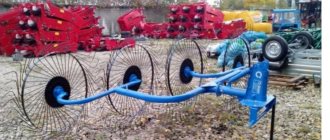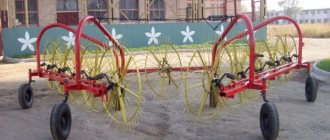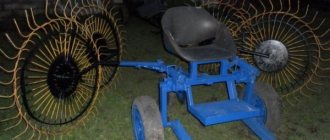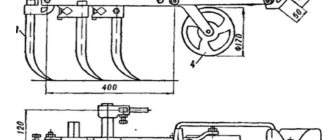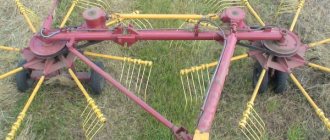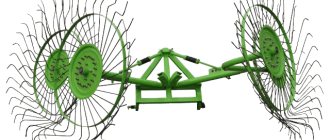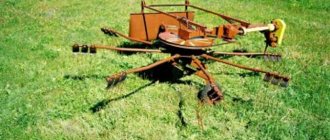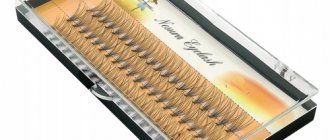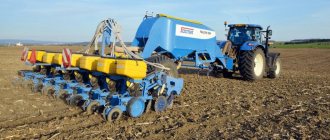Along with complex high-performance machines, a number of auxiliary mechanisms are used in agriculture. They are designed to simplify the transition between different technological operations, as well as to improve operational efficiency and product quality. A separate niche is occupied by devices for automated work with mowing.
Rotary rake tedder "GVR-630"
The unit is produced at the Belarusian enterprise Bobruiskagromash, known as a manufacturer of a wide range of auxiliary equipment. In all of its products, the company focuses on the relative simplicity of the mechanism, which improves the stability of operation. The composition of the models' control systems is kept to a minimum, which does not reduce their efficiency compared to the work of foreign models.
Purpose
Rake-tedders are used for intermediate preparation of mowing on the field, as well as maintaining proper drying, which prevents rotting. Particularly effective is windrowing, which is characterized by a low proportion of unharvested plant residues.
The location of the main elements allows for the reverse operation - uniform scattering of previously collected and laid windrows across the field. The unit is multifunctional and suitable for tedding and wrapping windrows during hay harvesting.
Peculiarities
The GVR-630 model does not have its own power and is used in conjunction with wheeled tractors through a hydraulic system and a power take-off shaft. The wide, lateral design requires the operator's attention to ensure safety when stopping and moving.
The working body of the unit was manufactured in Italy and is used in this model without significant modifications. To compensate for the loads that arise during heavy traffic, numerous spring-loaded units with increased survivability are used.
This sample is one of the few models in which spare parts from third-party manufacturers are often of higher quality than the original ones. This allows you not to wait for components from the manufacturer, but to use the capabilities of local enterprises.
Photo of tedder rake GVR-630
Belt cross rake
These machines are a mounted horizontal drive belt conveyor with spring-finger combs. The belt working element works across the tractor stroke, ensuring raking of the windrow to the side.
Belt mounted tractor rakes
Such raking devices are characterized by a small working width of 2 to 3 m. The machines have low productivity and are used for raking and tedding hay. The machine works especially well in areas with a high density of hay in thick hay fields.
Rakes and tedders for tractors
Home // Catalog of agricultural equipment // Forage equipment
Rakes-rakes Sipma ZK-350 / 450 / 650 WIR one and two rotors
Working width, m – 3.5 / 4.5 / 6.5; Windrow width when raking, m – 0.6-1.4 / 0.8-1.6 / 0.8-1.8; Productivity, ha/h – 3.5 / 4.5 / 6.5; Number of rotors, pcs. - 12; Production – Sipma (Poland).
price from 507,000 rub.
Rotary tedder rake SaMASZ P4 / P6 / P8
Working width, m – 4.7 / 5.3 / 7 / 7.7 / 8; Productivity, ha/h – 5.6 / 6.3 / 7.8 / 9.2 / 10.6; Number of rotors, pcs. – 4 / 6 / 8; Manufactured by SaMASZ (Poland).
price from 945,000 rub.
Combined rake SaMASZ TWIST 600 for front or rear mounting
Working width, m – 6; Windrow width when raking, m – 1.3; Productivity, ha/h – 6; Manufactured by SaMASZ (Poland).
price 1,730,000 rub.
Wheel-finger rake-rakes Sitrex MKE-16 / 18 / 20 Evolution Magnum V-shaped
Working width, m – 9.4 / 10.5 / 11.4; Windrow width when raking, m – 0.9-1.8; Productivity, ha/h – 11.3 / 12.6 / 13.7; Production - Italy.
price from 980,000 rub.
Rotary rake-tedder GVR-630
Working width, m – 6.3; Windrow width when raking, m – 1.8; Productivity, ha/h – 7; Number of rotors, pcs. – 2; Production – BobruiskAgroMash (Republic of Belarus, Bobruisk).
price 490,000 rub.
Rotary rake-tedder GVR-6
Working width, m – 6; Windrow width when raking, m – 1.2; Productivity, ha/h – 7.5; Number of rotors, pcs. – 2; Production – Tekhmash (Republic of Belarus).
price 515,000 rub.
Rotary rake-tedder GVR-6R
Working width, m – 6; Windrow width when raking, m – 1.4; Productivity, ha/h – 7; Number of rotors, pcs. – 2; Production - Russia.
price 450,000 rub.
Wheel-finger rake-tedder GVK-7.0P, semi-trailer
Working width when tedding, m – 9; Working width when raking, m – 7; Windrow width when raking, m – 1.4; Productivity, ha/h – 7-9; Production - Russia.
price 115,000 rub.
Tedder rakes are agricultural equipment that is used for raking grass, tedding grass in mowing areas, raking grass into windrows, and wrapping windrows of cut grass.
Classification:
- According to the nature of the roll formation: transverse;
- lateral.
- dental system;
- tractor;
- trailed;
In order to rake the grass from the swaths into windrows and turn over the mown grass, tedder rakes are used. After raking, the windrows are turned over and scattered. In conditions of high humidity, tedders help to quickly dry the cut grass so that the final product, hay, meets the highest requirements.
To implement the functions of high-quality tedding, fast and efficient drying, preservation and minimal damage to stubble, which has a positive effect on germination and growth rate, special tedders are used.
Advantages of rotary tedders.
The springs on the rotor fingers have springs with several teeth (two or more) to ensure load uniformity and optimal reproduction of the field topography. The torque is transmitted by devices of equal angular velocities - cardan-type joints similar to automobile CV joints; the drive is smooth and protected from unauthorized start-up during transportation. The drive of the working rotors is rigidly fixed, the tedding height is adjustable, as is the angle of attack. This is done by bending and turning the tedder wheels. Following surface unevenness is ensured by a special wheel (may not be included as standard).
The main purpose of tedder rakes is to rake grass from swaths into windrows. The equipment is a wheel-finger structure made of thickened pipe, which ensures the strength and reliability of the structure. The operating principle of tedder rakes is based on independent and interchangeable raking wheels, which are mounted on bearings.
The system adapts to any type of surface for raking, tedding and wrapping, because... There is a shock absorption system. The wheels consist of raking fingers, which are made of high-strength steel.
The running gear of the rake operates on hinges. The raking rings are independent of the chassis, allowing the system to work in almost any conditions.
Cross rake
The prototype of the cross rake was developed back in “antediluvian times” and was used with horse traction. The rake is a transverse beam on a pair of running wheels with a package of hinged arc-shaped finger spring combs. The ends of the fingers are located vertically to the field surface, ensuring raking of hay as the tractor moves.
Cross horse rake
The tractor standard model was presented in a trailed version, where, when raking, windrows were formed by releasing the mass of collected hay from a filled comb by lifting it using a hydraulic cylinder as part of the agricultural machine. cars.
Cross rake
Today, converted models of such rakes are used in a mounted version with a significant reduction in their working width. Such rakes do a fairly good job of raking hay, but do not perform the tedding function well. In addition, the formation of a windrow for collecting hay is carried out not by the movement of the tractor, but across the movement when composing parts of the collected hay in parallel passes of the unit. This type of work is somewhat inconvenient for uniform formation of windrows on the field.
Finger transverse wide-grip rake in transport position
Rotary or rotary rakes
Depending on the functionality of the model, powered rotary rakes can perform hay raking into a windrow, twining two or more windrows into one, tedding by spreading and turning over to increase air access to the dried grass clippings. The working body of the machine receives drive from the PTO of the mounted tractor and is a horizontal rotor with vertical finger combs, which, during the turning cycle, can lower to the ground surface, capturing hay, and rise, dumping it.
Mounted rotary tractor rakes
According to the type of aggregation in the model range of machines of this type, there are both mounted - single-rotor mounted, and two, four, six rotor - trailed versions. By changing the direction of rotation of the rotors and reconfiguring the operating order of the finger combs, the operating mode of the machine is established.
Trailed two-rotor unit
The carousel type of rake has proven itself well in fields with flat terrain, where the units have shown high productivity and quality of work.
Trailed high-performance unit with rotary rake
Types of rakes
Considering that the operation of an agricultural machine is not associated with heavy loads when raking and tedding hay, all types of devices are distinguished by their lightness and simplicity of design. Regardless of the type of design, the rakes are perfectly combined with wheeled tractors in the 0.9 and 1.4 t.p. traction classes, such as T-40, MTZ-80, YuMZ-6. Among the existing types there are both drive devices and those operating purely due to the movement of the tractor.
- Transverse
- Rotary
- Tape
- Roller rake
